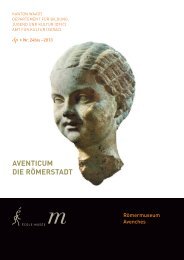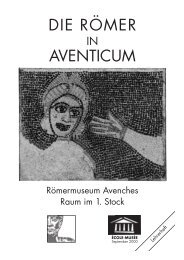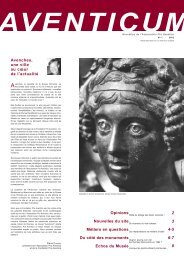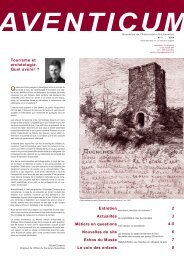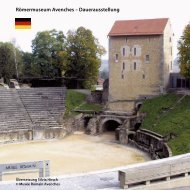Avenches – Roman Museum – Permanent Exhibition
Avenches – Roman Museum – Permanent Exhibition
Avenches – Roman Museum – Permanent Exhibition
You also want an ePaper? Increase the reach of your titles
YUMPU automatically turns print PDFs into web optimized ePapers that Google loves.
Ground Floor The Gallo-<strong>Roman</strong> Population of Switzerland and Their View of Death<br />
The Extraordinary Finds at the Necropolis of En Chaplix<br />
The deceased was buried in an oak trunk. The rich grave goods given to her (1)<br />
consisted of a bronze jug, a glass bottle and two glass goblets, a pot or goblet made<br />
of soapstone, a ceramic cup, a partly silver-plated bronze spoon, a necklace made of<br />
glass and jet beads, a jet bracelet as well as four bone sticks (not exhibited).<br />
The glass goblets bear engravings, which are among the earliest evidence of the<br />
Christian faith found in western Switzerland. On the bigger vessel, the Latin inscription<br />
Vivas in Deo<br />
«May you live in God»<br />
clearly refers to the hope of resurrection. The smaller goblet shows an inscription in<br />
Greek, partly preserved, abbreviated and transcribed with Latin letters,<br />
Pie zezes<br />
«Drink that you may live»<br />
which affirms that eternal life is obtained by holy communion.<br />
1. Bronze jug.<br />
2. Glass bottle.<br />
3. Glass goblet with the inscription Vivas in Deo (“May you live in God”)<br />
4. Glass goblet with the inscription pie zezes (“Drink that you may live”)<br />
5. Bronze spoon.<br />
6. Pot or goblet made of soapstone.<br />
7. Ceramic cup.<br />
8. Glass and jet bead necklace.<br />
9. Jet bracelet<br />
The Extraordinary Finds at the Necropolis of En Chaplix<br />
During the construction of the motorway important archaeological remains were<br />
discovered in En Chaplix (2), situated at a distance of approximately 150 m from the<br />
north-east gate of Aventicum.<br />
The first sanctuary was erected around 15/10 BC, during the reign of the<br />
emperor Augustus (27 BC <strong>–</strong> AD 14). In the middle of an open square, bordered by<br />
a ditch, a wooden aedicule (small wooden temple) sheltered the cremation burial<br />
of a woman and probably her child. The discovery of two fibulae originating from<br />
regions either along the Danube or in the eastern Alps indicate that the deceased<br />
may have come from that area. The numerous coin offerings prove that this tomb<br />
had become a place of veneration.<br />
During the reign of Tiberius (AD 14 <strong>–</strong> 37) the En Chaplix site grew in a rapid<br />
and spectacular way (3). The construction of a road leaving Aventicum in the<br />
northeast was followed by the reconstruction and extension of the first sanctuary.<br />
The aedicule was replaced by a small Gallo-<strong>Roman</strong> temple (fanum) and a chapel.<br />
A similar complex was erected directly beside it. The timber walls were probably<br />
inserted into masonry foundations. These sanctuaries were frequently visited in the<br />
1st century in particular and remained intact well into the 4th century AD.<br />
1<br />
2<br />
3<br />
12<br />
Ground Floor<br />
5



